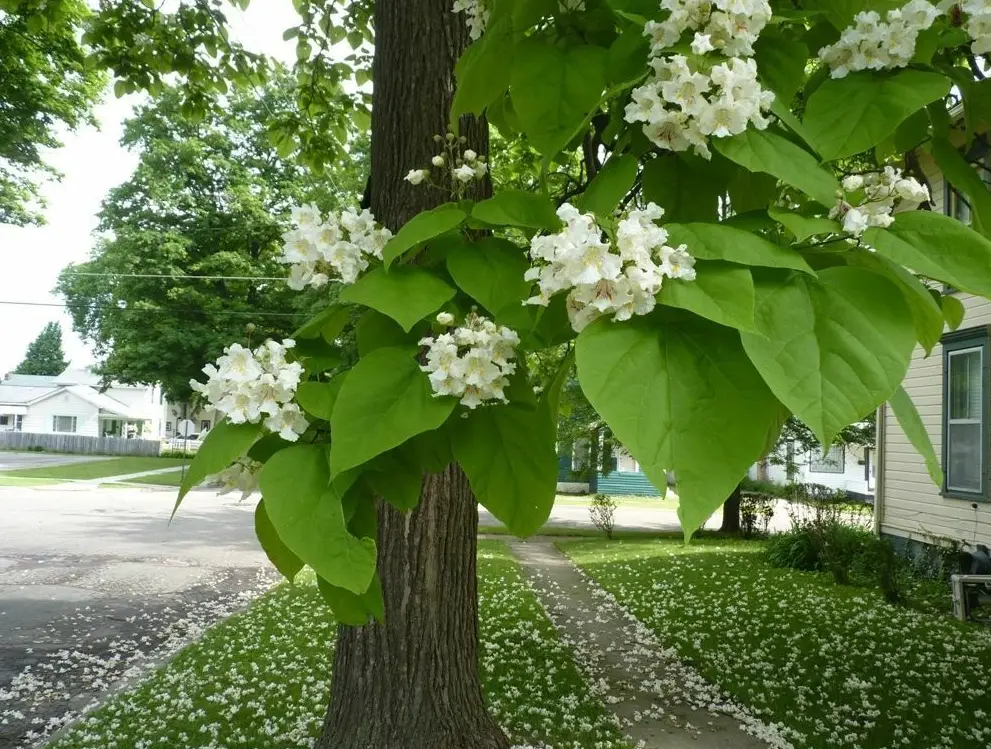The catalpa tree (Catalpa spp.) is a majestic and popular tree species recognized for its impressive height, broad heart-shaped leaves, and clusters of white, fragrant blossoms. These trees are not only appreciated for their beauty but also for their utility in providing shade and attracting wildlife.
In this comprehensive guide, you’ll discover how to successfully grow and care for a catalpa tree, ensuring it thrives for years to come.
Understanding the Catalpa Tree

Catalpa trees are well-known for their distinctive appearance. Their heart-shaped leaves can grow up to 12 inches long and 8 inches wide, creating a lush canopy. The trees also bear long, dark seed pods that add unique visual interest throughout the year.
Despite being labeled as a “weed tree” in some areas due to its fast growth and tendency to pop up unexpectedly, the catalpa remains a favorite for homeowners and landscapers alike. This is due to its elegance, shade-providing qualities, and ability to attract pollinators such as bees, butterflies, and hummingbirds. Additionally, the catalpa tree is the sole host for the catalpa sphinx moth, making it a valuable part of the ecosystem.
Key Features of the Catalpa Tree
- Common Names: Catalpa, cigar tree, catawba, western catalpa
- Botanical Name: Catalpa spp.
- Family: Bignoniaceae
- Type: Deciduous tree
- Height: 40-60 feet tall
- Spread: 20-40 feet wide
- Flower Color: White
- Zones: USDA Hardiness Zones 4-8
- Native Areas: North America, Caribbean, East Asia
How to Care for a Catalpa Tree
Light Requirements
Catalpa trees thrive in full sun, making sunlight one of the most important factors for healthy growth. For optimal results, catalpa trees require at least four hours of direct sunlight every day. When planted in full sun, these trees develop stronger branches, more vibrant blooms, and a fuller, more symmetrical canopy.
While catalpa trees can survive in partial shade, areas with limited sunlight may lead to slower growth, fewer blooms, and a less robust structure. Maximizing exposure to sunlight ensures that the tree reaches its full height potential and produces its signature heart-shaped leaves and white blossoms in abundance.
Whether you’re planting in an open yard or near structures, always aim for a location where the tree can bask in direct sunlight for several hours to promote healthy, vigorous growth.
Soil Preferences
Watering Needs
Catalpa trees are highly drought-tolerant once they are well-established, making them an ideal choice for gardens in areas with fluctuating water availability. During the first few years after planting, however, regular watering is essential to help the tree develop a deep and strong root system. Proper watering during this period ensures that the catalpa tree has the resources it needs to thrive as it matures.
In periods of extreme drought, providing supplemental water is highly beneficial. Even though catalpa trees are resilient to dry conditions, additional watering during prolonged dry spells will help maintain the tree’s health, ensuring it continues to produce its lush, green leaves and maintain its structural integrity. Consistent but not excessive watering helps the tree withstand both drought and excessive rain.
Temperature and Humidity
Catalpa trees, native to warm temperate regions, are incredibly hardy and can thrive in USDA zones 4-8. This makes them adaptable to a wide range of climates, from areas with cold winters to regions that experience hot summers. Their ability to tolerate such temperature extremes makes them an excellent choice for many different landscapes.
When it comes to humidity, catalpa trees are quite resilient. They can thrive in both humid and dry environments, making them suitable for various locations without the need for special care related to moisture in the air. Whether in coastal regions with high humidity or in more arid areas, catalpa trees continue to grow robustly, demonstrating their adaptability across climates.
Fertilization
Catalpa trees typically do not require frequent or heavy fertilization, particularly if they are planted in fertile, loamy soil. These trees are quite self-sufficient in nutrient-rich environments. However, if your soil is sandy or clay-heavy, applying a balanced 10-10-10 fertilizer after planting can help boost early growth and ensure that the tree establishes a strong root system.
Fertilization is most necessary during the early years of the tree’s life or if it shows signs of struggling, such as stunted growth or poor leaf development. In such cases, a light application of fertilizer once a year can provide the extra nutrients needed for the tree to thrive. Generally, once established, catalpa trees require minimal additional nutrients to maintain their health and vitality.
Pruning for Optimal Growth
Types of Catalpa Trees
There are several species of catalpa trees, each with its own unique characteristics:
- Northern Catalpa (Catalpa speciosa): Known for its larger leaves, flowers, and seed pods, this species is native to the central and eastern United States.
- Southern Catalpa (Catalpa bignonioides): Native to the southeastern United States, this species is slightly smaller but equally attractive, often planted as a garden tree.
- Chinese Catalpa (Catalpa ovata): This variety is native to East Asia and is recognizable by its yellow flowers, making it a distinctive addition to gardens.
- Haitian Catalpa (Catalpa longissima): Known for its beautiful, pink-tinged flowers.
Propagation and Growing Catalpa Trees from Seed
Catalpa trees are relatively easy to propagate from seeds or cuttings. They are fast growers, but it can take 5-7 years for a catalpa tree to reach maturity and produce its iconic seed pods and flowers.
Steps to Grow Catalpa from Seeds:
- Collect seeds from the seed pods in fall.
- Refrigerate the seeds until spring.
- Direct sow the seeds after the last frost in well-draining potting soil.
- Keep the soil moist and place the container in a sunny spot.
- Once seedlings reach 3-4 inches tall, transplant them into their permanent location.
The seeds germinate readily and will grow into healthy saplings with minimal effort.
Common Pests and Diseases
While the catalpa tree is resilient, it can occasionally fall prey to pests and diseases. The catalpa sphinx moth larva, while a native insect, can cause significant defoliation if infestations are heavy. Other potential issues include:
- Powdery mildew
- Leaf spot
- Twig blight
These diseases are often cosmetic and can be treated with standard fungicides or by maintaining proper air circulation around the tree.
Common Problems with Catalpa Trees
Despite its many benefits, the catalpa tree has a few drawbacks that you should consider before planting:
- Messy Seed Pods: The long, cigar-like seed pods are fascinating but can create a mess when they fall. They may pose a slipping hazard on sidewalks and can clutter landscapes if not cleaned up regularly.
- Leaf Litter: Like many deciduous trees, the catalpa sheds a large volume of leaves in autumn. While these leaves decompose quickly, they can create extra work for property owners near busy areas.
Conclusion
The catalpa tree is a wonderful addition to any landscape, offering shade, beauty, and habitat for wildlife. With its adaptability to different soil types and climates, it’s a relatively low-maintenance tree that rewards homeowners with spectacular blooms and unique seed pods. By following this care and growing guide, you’ll ensure your catalpa tree thrives, providing a focal point for your yard for many years to come.
Whether you’re looking for a shade tree, a wildlife attractor, or simply a striking feature in your garden, the catalpa is an excellent choice. Just remember to prune regularly, provide adequate sunlight, and manage the seed pod litter, and you’ll enjoy the many benefits this tree has to offer.







But does it make sense to tap its sap to make syrup?